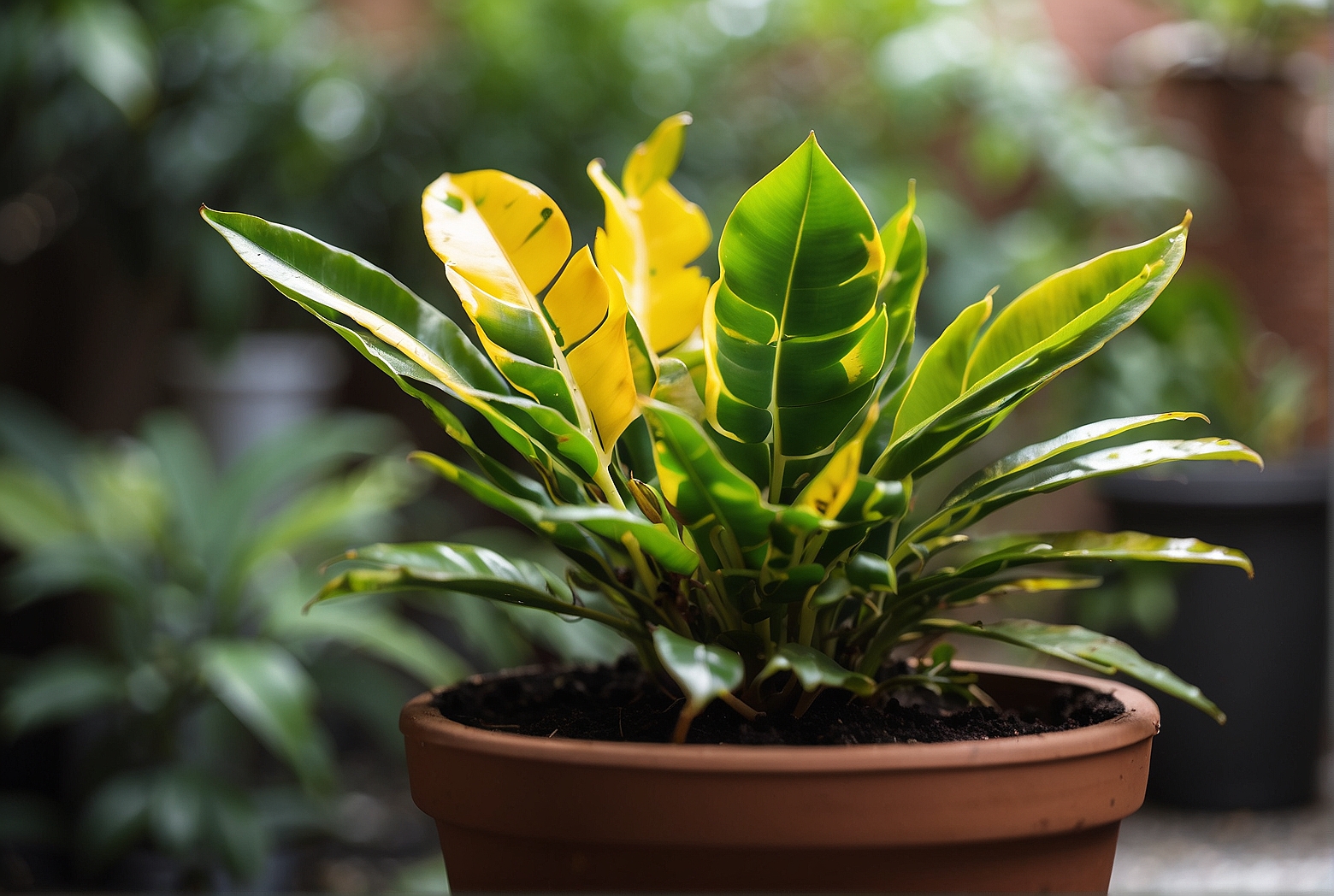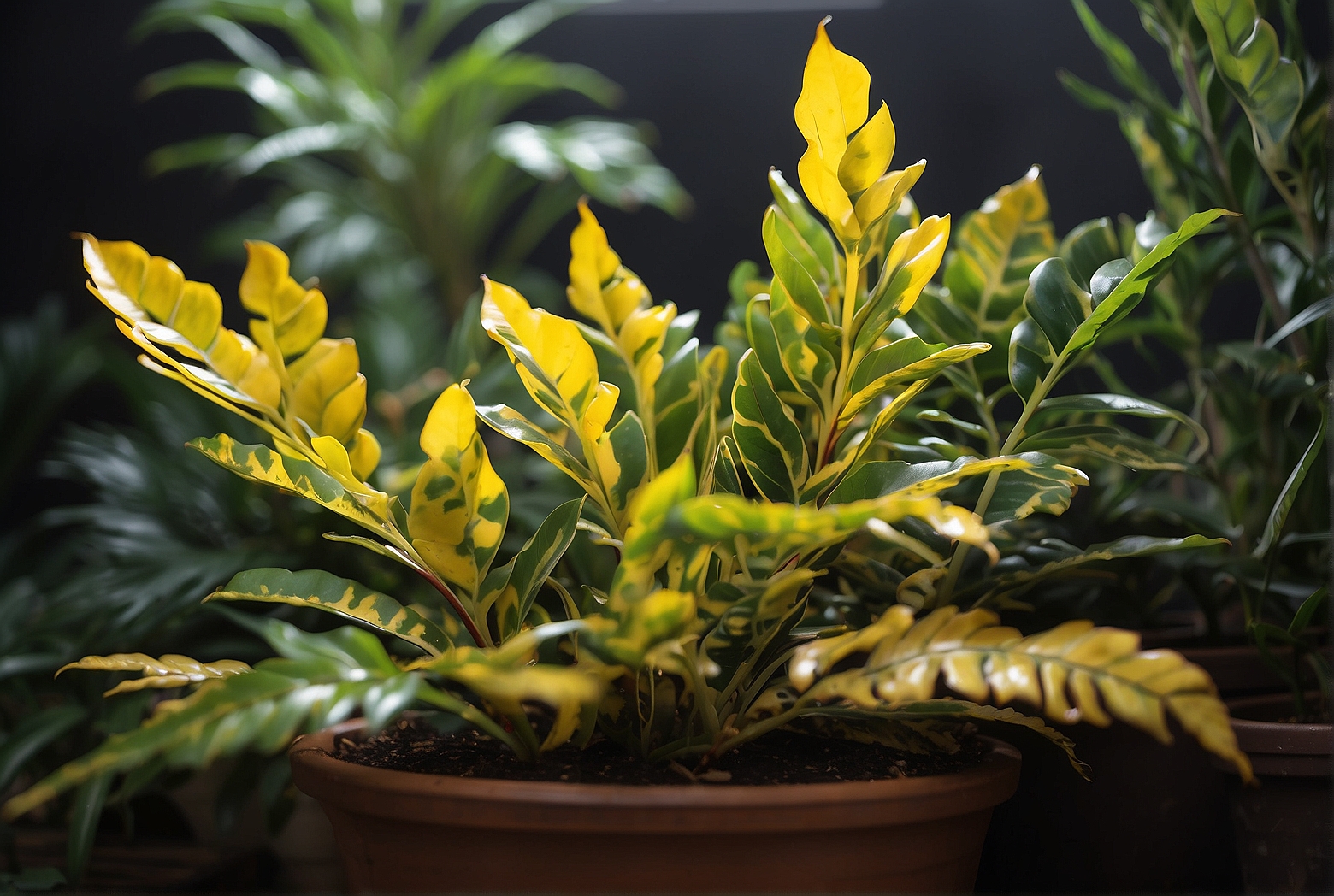Last Updated on April 7, 2024 by Tony Manhart
Are you in a state of worry over the sudden appearance of yellow leaves on your beloved ZZ plant? Fear not, for we are here to shed some light on this puzzling phenomenon. As a plant enthusiast, it is natural to be concerned about the health of your plants, and the yellowing of leaves can be quite alarming. However, there are several factors that could contribute to this change in color. By understanding these potential causes, you can take the necessary steps to ensure your ZZ plant flourishes once more.
Overwatering
Excessive Moisture
Overwatering is a common issue that many plant owners face. When you water your plants excessively, you are providing them with more moisture than they need. This can drown the roots and lead to a variety of problems, including yellowing leaves. Plants need a balance of water and oxygen to thrive, so it’s important to avoid overwatering.
Poor Drainage
Another reason for yellow leaves in your ZZ plant could be poor drainage. If the water you provide is not able to drain properly, it can accumulate in the pot and saturate the soil. This leads to excessive moisture and suffocates the roots. Placing your ZZ plant in a pot with drainage holes can help alleviate this issue and prevent yellowing leaves.
Root Rot
Overwatering and poor drainage can lead to a condition called root rot. When the roots are constantly sitting in water, they become susceptible to fungal and bacterial infections. This causes them to rot and prevents them from absorbing water and nutrients properly. Yellow leaves can be a symptom of root rot, along with brown, mushy roots. To prevent this, make sure to let the soil dry out between waterings and provide proper drainage for your ZZ plant.

Underwatering
Insufficient Water Supply
On the other hand, underwatering can also cause yellow leaves in your ZZ plant. If you don’t provide enough water, the plant becomes dehydrated and unable to function properly. The lack of water inhibits nutrient uptake and leads to yellowing leaves. It’s crucial to find the right balance and water your ZZ plant when the top inch of soil feels dry.
Low Humidity
ZZ plants are native to regions with high humidity, so low humidity levels can also contribute to yellowing leaves. In dry environments, the plant loses water more rapidly, leading to dehydration and stress. You can increase humidity by placing a tray of water near the plant or using a humidifier. Misting the leaves occasionally can also help maintain adequate humidity levels.
Dry Soil
Underwatering can cause the soil to become dry, which affects the plant’s ability to absorb water and nutrients. Dry soil leads to stressed roots and yellowing leaves. To address this issue, make sure to water your ZZ plant thoroughly and ensure that the water penetrates the entire root system. Avoid letting the soil completely dry out, but also make sure not to overwater.
Improper Light
Direct Sunlight Exposure
While ZZ plants can tolerate low light conditions, they can suffer from yellow leaves if exposed to direct sunlight for extended periods. The intense rays of the sun can scorch the leaves, causing them to turn yellow and brown. To prevent this, place your ZZ plant in a location with indirect or filtered light. If you notice yellowing leaves due to excessive sunlight, move the plant to a more suitable spot.

Insufficient Light
On the other hand, insufficient light can also lead to yellow leaves in your ZZ plant. These plants thrive in bright, indirect light, and if they don’t receive enough, they may become weak and pale. Lack of light affects the plant’s ability to photosynthesize and produce energy, resulting in yellowing leaves. Ensure that your ZZ plant is placed in a well-lit area, but away from direct sunlight.
Nutrient Deficiency
Lack of Nitrogen
Nitrogen is an essential nutrient for plants, and a lack of it can cause yellow leaves. Nitrogen is responsible for the production of chlorophyll, which gives leaves their green color. Without enough nitrogen, the leaves cannot produce sufficient chlorophyll, resulting in yellowing. To address this, apply a balanced fertilizer that contains nitrogen according to the manufacturer’s instructions.
Insufficient Iron
Iron is another important nutrient that plays a role in the production of chlorophyll. When your ZZ plant lacks iron, it cannot synthesize enough chlorophyll, leading to yellow leaves. You can provide iron to your plant by using a fertilizer specifically formulated for iron deficiency. Additionally, adjusting the pH of the soil can help improve iron availability to the plant.
Potassium Deficiency
Potassium is necessary for overall plant health and plays a role in numerous vital functions, including water uptake and nutrient transport. A deficiency of potassium can cause yellowing and browning of leaves, as well as weak growth. To prevent this, use a fertilizer with a balanced ratio of nutrients, including potassium. Regularly feeding your ZZ plant can help ensure it receives an adequate supply of potassium.
Pest Infestation
Mealybugs
Mealybugs are small, sap-sucking insects that can infest your ZZ plant. They often appear as white, cotton-like clusters on the leaves and stems. Infestations can weaken the plant, causing yellowing leaves and stunted growth. To treat a mealybug infestation, gently wipe the affected areas with a cotton swab soaked in rubbing alcohol. For severe infestations, you may need to use an insecticidal soap or seek professional help.
Spider Mites
Spider mites are another common pest that can cause yellowing leaves in your ZZ plant. These tiny pests feed on plant sap, causing leaf discoloration, stippling, and webbing. Spider mites thrive in dry conditions, so increasing humidity can help prevent infestations. You can also try using water sprays to physically remove the pests from your plant or use insecticidal soaps.
Temperature Stress
Cold Temperatures
ZZ plants are sensitive to cold temperatures and should be kept away from drafts or areas with low temperatures. Exposure to cold air can damage the leaves, causing them to turn yellow. Ideally, maintain temperatures between 65-75°F (18-24°C) for your ZZ plant. If temperatures drop below this range, consider moving your plant to a warmer location and protecting it from cold drafts.
Heat Stress
High temperatures can also cause stress and yellowing in ZZ plants. Extended exposure to hot, dry conditions can lead to wilting, scorched leaves, and yellowing. To prevent heat stress, avoid placing your plant near heating vents or in direct sunlight during hot summer months. Maintain adequate humidity levels and provide shade if necessary. Regularly inspect your ZZ plant for signs of heat stress and take appropriate measures to protect it.
Indoor Air Quality
Poor Air Circulation
Poor air circulation can negatively impact your ZZ plant’s health and lead to yellowing leaves. Stagnant air can contribute to mold growth, fungal infections, and the accumulation of dust on the leaves. Ensure that your plant has adequate airflow by placing it near a door or window that is frequently opened. You can also use a fan to improve air circulation in the room.
Chemical Exposure
Indoor air quality can be compromised by the presence of chemicals and pollutants. These can come from cleaning products, cigarettes, or even off-gassing from furniture. Exposure to these chemicals can cause stress to your ZZ plant, resulting in yellowing leaves. To minimize chemical exposure, use natural cleaning products, avoid smoking indoors, and ensure proper ventilation in your home.
Transplant Shock
Repotting Issues
When transplanting your ZZ plant, it may experience transplant shock, leading to yellow leaves. Transplant shock occurs when the roots are disturbed or damaged during the repotting process. To minimize this, be gentle when handling the plant, and try not to disturb the roots too much. Ensure that the new pot is the appropriate size and provide proper drainage to prevent waterlogging.
Root Disturbance
Apart from repotting issues, other forms of root disturbance can also result in yellow leaves. This may include accidental damage during routine maintenance or planting new plants nearby. Be cautious when tending to your ZZ plant and avoid damaging the roots. If root disturbance occurs, monitor the plant closely and provide optimal care to help it recover.
Disease
Bacterial Infection
Bacterial infections can affect ZZ plants and cause yellowing leaves. These infections often occur as a result of overwatering or poor hygiene practices. Symptoms may include yellowed or necrotic spots on the leaves, as well as a foul odor. To prevent bacterial infections, ensure proper watering techniques, provide good air circulation, and avoid overcrowding plants.
Fungal Disease
Fungal diseases, such as root rot or leaf spot, can also lead to yellow leaves in ZZ plants. These diseases thrive in moist conditions, making overwatering a common cause. Fungal infections can cause yellow patches, leaf discoloration, and overall plant decline. To prevent fungal diseases, allow the soil to dry out between waterings and ensure proper drainage. Avoid splashing water on the leaves and provide good air circulation.
Natural Aging
Leaf Shedding
As part of their natural life cycle, ZZ plants will shed older leaves. When these leaves turn yellow and start to wilt, it’s a sign that they are aging and will soon fall off. This is a normal process and shouldn’t cause concern, especially if new leaves continue to grow. Regularly remove any yellowed or dead leaves to maintain the plant’s appearance.
Normal Yellowing
It’s important to note that some yellowing of older leaves can occur even without any underlying issues. As the plant matures, older leaves naturally yellow and eventually die off. This is a normal part of the plant’s growth cycle and shouldn’t be a cause for worry. As long as new leaves continue to emerge and the overall health of the plant is maintained, this yellowing is nothing to be concerned about.
In conclusion, there are various factors that can cause the leaves of your ZZ plant to turn yellow. Overwatering, underwatering, improper light, nutrient deficiencies, pest infestations, temperature stress, indoor air quality, transplant shock, disease, and natural aging are all potential culprits. By understanding and addressing these factors, you can ensure the health and vibrancy of your ZZ plant’s foliage. Remember to provide appropriate watering, lighting, and nutrients, as well as create a conducive environment for your plant’s growth. With proper care, your ZZ plant will continue to flourish, and its leaves will remain lush and green.
Tony Manhart is a passionate gardener who has been tending to gardens for over 20 years. He takes pride in creating beautiful outdoor spaces with plants, trees, and shrubs that can thrive in any environment. He loves to share his knowledge with others and has taught classes on gardening basics and advanced techniques. He is committed to sustainability, using natural and organic methods to create and maintain gardens. He also works with local organizations to create green spaces for communities. When he’s not gardening, Tony enjoys hiking, reading, and spending time with his family.


